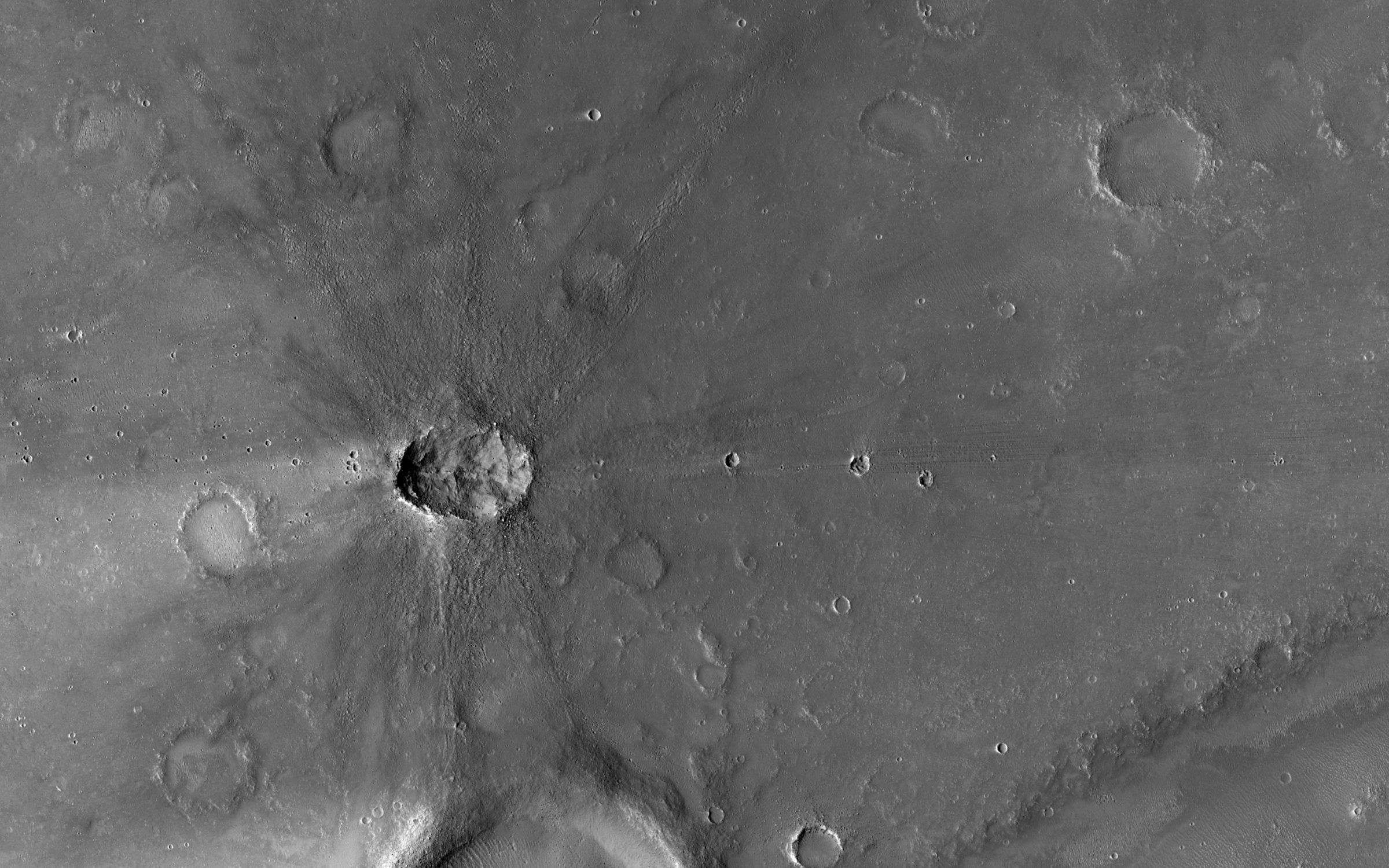Emily Lakdawalla • Nov 08, 2012
Beautiful butterfly crater on Mars (another HiWish granted!)
Yesterday the HiRISE team released a slew of data to the Planetary Data System. Whenever they do that, a bunch of automatic emails get sent to the lucky people who have had their HiWishes granted. I got one of those emails! Hooray! (What is a HiWish? Here's an explanation.)
It's been quite a long time since I last submitted a HiWish -- a request for a HiRISE image of a specific spot on Mars -- and, to be honest, I'd forgotten about my requests. My first few HiWish images have been, I have to admit, somewhat disappointing. How could it possibly be disappointing to have a spacecraft take a picture on another planet at your request, do you ask? The problem is that Mars is a dusty place, and if there's enough dust in a region, it smoothes out surface detail to the point that you don't gain much by zooming in from the resolution of Mars Global Surveyor's MOC or Mars Reconnaissance Orbiter's Context Camera. Almost all of my previous HiWish images have been like that: so dusty that I couldn't really see much of anything new in the pictures.
My luck finally changed. Actually it wasn't entirely luck; I'll explain that below. First of all, though, here is part of the picture that Mars Reconnaissance Orbiter took at my request:

The reason that this request turned out well is that I changed my approach to looking for good spots to HiWish. I began with the HiWish browse map. I switched the base map to the "nighttime infrared" image. At night, broadly speaking, bare rock is warmer than dust, so rockier areas will generally look brighter and dustier areas will look darker; so I focus on lighter areas. Then I zoom in just enough that I can start seeing the HiRISE image footprints. Then I browse around for areas with a dearth of HiRISE coverage. If I see an area that has potential, I switch on the CTX layer to see if it's been covered by CTX (or if not, by MOC). If it has, I check out the CTX image. Does it still look interesting? Do I feel like there's probably details I can't make out in the 6-meter resolution of the CTX image -- is it worth zooming in further? If the answers to those last two questions are "yes," I make a request.
Last time I followed that chain, I saw an interesting dark "splat" on an otherwise fairly smooth surface. A dark splat, on Mars, is usually a fresh crater. They're dark because the crater has thrown out blocks of rock, and blocks of rock cast shadows, while smooth flat plains don't (as much). From the distance of orbit, we may not be able to see individual rock blocks, but the cumulative effect of their shadows is to darken the surface. Wherever there are boulders that haven't been eroded or buried, the surface is darkened.
Zooming in on the CTX image, I noticed that the splat was not radially symmetrical; there seemed to be missing sectors both to the west and to the east. Moreover, the crater itself was elliptical. Both of those observations are strong hints that this was a highly oblique impact, with the impactor coming in at a shallow angle less than 10 degrees up from horizontal. When that happens, most of the ejecta gets flung out sideways, making a characteristic butterfly shape.
I love butterfly craters. Every world has them, though they have slightly different personalities from place to place. This one is quite fresh, very small, and beautifully preserved. Zooming way in, taking advantage of the full HiRISE resolution of 50 centimeters per pixel, you actually can make out those individual shadow-casting blocks of rock. The biggest one I see here is 6 or 8 meters across. A very small field of dunes in side the crater hints that it's been a while (thousands to hundreds of thousands of years, maybe?) since the crater formed, but it's still brand-new, by Martian standards.
But what makes this image really special is what you see when you zoom in on the rays downrange of the crater (which is, I am going to argue, to the right or east). Not a lot of the ejecta went in that direction, but the stuff that did, was charged with the velocity of the original impactor, a shotgun blast of ricocheted material. Below, I've taken a selection along the downrange direction and rotated it 90 degrees to squeeze it onto this page at its full resolution. The area we're looking at is 420 meters wide. I am not sure, but I think we're seeing obliquely impacting secondary craters in here. The largest one has a ray leading straight to it and a blast of rays emanating from it. I can imagine a big 20-meter-ish chunk of the original impactor or of rock torn from the ground spinning and disrupting and shedding material as it flies out of the crater, strafing the ground with gravel, rat-tat-tat-tat, then crashing itself and exploding into smithereens, gouging out that secondary.
I'm very happy with my HiWish! I immediately returned to the HiRISE website and submitted a new request, for a second image of the same spot from a different angle, so that I can see this beautiful, fresh crater in stereo. Let's hope my wish is granted!
Let’s Go Beyond The Horizon
Every success in space exploration is the result of the community of space enthusiasts, like you, who believe it is important. You can help usher in the next great era of space exploration with your gift today.
Donate Today

 Explore Worlds
Explore Worlds Find Life
Find Life Defend Earth
Defend Earth



